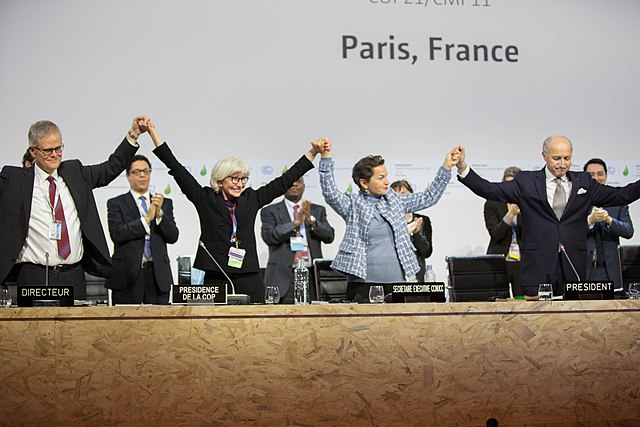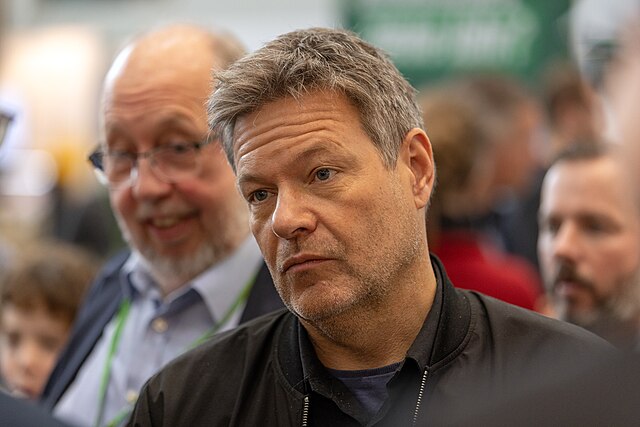It was a moment in time. A landmark agreement. What Grist dubbed as a “big fucking deal”—although, in a depressing parallel to the events of last year, was also in 2016 predicted to be buried under U.S. election and presidential-related coverage.
By all accounts, the Paris Agreement was a historical event, and one that—no matter how overshadowed it may have been—offered a sense of hope and potential mitigation against the swell of climate change. The legally-binding international treaty on climate change was signed by 196 Parties at the UN Climate Change Conference in Paris, France, on 12th of December 2015, and officially came into force on the 4th of November 2016. The overarching goal sounded simple, though not easy: limiting global warming to 1.5 degrees Celsius above pre-industrial levels. The countries who signed agreed to strengthen their commitments over time, severely reduce emissions, and provide assistance towards developing countries in adapting to and mitigating the effects of climate change.
Even at the time the document was drawn up, many experts believed that the agreement was not authoritarian enough. Despite that, it was lauded as a promising first step in the world transitioning to a cleaner, healthier, more equitable and safe space. Scientists spoke with cautious urgency. “My biggest concern really is that we are only on the first step of a ladder of increased ambition. It is going to become clear to the world over the next 3 -5 years how much more we need to do to stabilise the climate,” Shane Tomlinson told BBC News in 2016. Tomlinson’s words could not have been more prophetic.
Making up the core of the Paris Climate Agreement are countries’ Nationally Determined Contributions (NDCs). Unique to each nation, the NDCs encompass each country’s pledge to reduce emissions, their specific targets, and their strategies and manner of implementing said strategies to mitigate and adapt to the effects of climate change. Countries who signed the legally binding agreement pledged to submit their NDCs in five-year intervals.
COP30, slated for this November, will see a decade since the Paris Agreement was drafted. The 30th United Nations Climate Change Conference will see world leaders, philanthropists, scientists, and government officials convene in Brazil, with one question in particular hanging overhead: is the Paris Agreement still alive?
Its goal was the rapid and effective slashing of emissions; the whole-hearted commitment of the most developed countries to helping the most vulnerable; renewing commitments year-by-year; and evidence showing that strides were made to mitigate human-made climate change.
One could imagine that hopes held by climate experts and scientists are dashed, even if the original document provided them with little in the first place. Fresh into his second term as the President of the United States, Donald Trump officially withdrew the country from the accord—an act he first put in motion when he originally took up residence in the White House in 2017, but was reversed when Joe Biden took over—alongside an alarming cry that America would “drill, baby, drill!” (a slogan originally popularized by former Maryland lieutenant governor Michael Steele). Instead of merely objecting to the terms of the agreement, Trump has made clear his eschewal of the concept of climate change in its entirety. He promises to boost fossil fuel production and roll back climate policies, many of which were fledgling initiatives left over from the Biden administration—even though oil producers themselves have expressed wariness at such a swift gear change, and top economists worldwide have also recommended taking advantage of the green transition for long-term positive growth.
It’s not just Trump that dubs climate change a hoax. Climate denial and misinformation has seen an alarming spike, with certain experts believing it will only get worse. And while it can be easy to cast the bogeyman as a figure across the pond, right-wing rhetoric has been sweeping across Europe for years and may have served as an example for the Trump administration’s quick moves in dismantling climate initiatives and policies. Climate denial and misinformation goes hand-in-hand with right-wing politics, favoring instead the belief of economic opportunity and constant, never-ceasing production. Pockets of social media websites echoing oil-fueled propaganda are seemingly ballooning.
Every corner of the globe has felt the impact of climate change acutely as well.
2024 was confirmed as the hottest year on record, prompting the World Meteorological Organization (WMO) to sound the red alert. According to their findings, one-third of the global ocean was gripped by a marine heatwave on an average day in 2023; glaciers suffered the largest loss of ice on record since 1950; the number of people who were food insecure doubled; and extreme weather events continued to trigger displacement, health issues, and death.
The start of 2025 saw the astounding and heartbreaking savagery of the Los Angeles fires, which were widely considered to be a domino effect of climate change. The fires saw the devastation of land and housing, grievous injuries and billions worth of losses. La Niña, a recurring climate fluctuation, typically lowers the global temperature by a fraction of a celsius. This year, due to the acceleration of human-caused warming and the excess carbon pumped into the atmosphere, La Niña has not caused a drop. Scientists have warned that as climate change becomes more vigorous, La Niña’s impact will dwindle further. Thus, 2025 is dutifully following the trend set by 2024: its January and February have both continued to smash records many would prefer to have fallen short of.
The surge of climate-related disasters has also led to the rise of attention from experts and leading organizations in the crucial relationship between health and climate. Dengue fever’s cascading effect globally since late 2024 has been linked with the higher temperatures speeding up the disease’s carriers replicating the virus internally. The World Health Organization (from which the Trump administration has also withdrawn) urged for the urgent integration of health in COP29’s climate negotiations. Mental health specialists have further raised the alarm on a peak in climate anxiety and brain fog; psychiatrists at COP29 underscored the relationship between extreme heat and suicidal behavior in young people.
Fundamentally, all signs point to further disasters, destruction, and disease. More and more reports and publications have brought to the forefront the varied and inextricable damage caused by climate change with the same message of caution: a canary in a coalmine.
This is where we stand: we are halfway through the Paris Agreement and research suggests that it will take twenty further years to reach the temperature goals that were set. The vast majority of countries missed the deadline to update their NDCs, and the withdrawal of the United States has served as an undeniable blow. As the foremost economical and military power, the U.S. currently has an unrivaled global influence, and news of Trump’s administration searing through climate finance is being pumped out at an astonishing rate. On Friday, Brazil’s Minister of the Environment and Climate Change, Marina Silva, delivered an impassioned critique of the United States’ withdrawal from the Agreement, and expanded on how the Trump-prompted trade war will threaten environmental progress. “They may drain resources and they also may hamper the environment of confidence and trust among parties. We have a triple negative effect because the less action we see, the less money we see, resulting in less cooperation across countries,” Silva said. “Trump’s friend Vladimir Putin must be ecstatic: the US president is tearing the West apart before his happy eyes,” Martin Wolf wrote for the Financial Times on Trump’s imposed tariffs.
The outpour of concern from scientists, politicians, government officials, researchers, and analysts seems to have fallen on deaf—or perhaps simply uninterested—ears in the Trump administration. It’s not only the Paris Agreement that has been thrown into disarray; the United States has also quit a flagship global financing program, the Just Energy Transition Partnership (JETP), putting its efforts towards assisting emerging economies to become independent from coal reliance in a highly precarious position. A slew of climate data and environmental justice tools have been scrubbed from the internet, the order of which has been linked back directly to the United States Department of Agriculture. Now that it seems to be confirmed that the U.S. has effectively opted to slam the door on the notion of climate change, and contribute with renewed energy to stoking the flames worldwide, it’s become clear that the world has to rally. The country that was once the most prominent and dominating of allies must now be the ground for a pivot towards renewed commitments and collaboration.
The situation is bleak and the danger ought not to be understated. Yet it is important also to pay attention to the world leaders, philanthropists, economists, and scientists urging for increased collaboration, ambitious public-private partnerships, and zealous efforts towards undoing global warming with speed and tenacity.
Although only a dozen countries submitted their updated NDCs on time, the United Kingdom is one of the few who achieved it, with a bold new target for the upcoming five-year cycle. Prime Minister Keir Starmer announced the objective in Baku in November 2024, and called for other countries to join the U.K. in redoubling their work towards reducing emissions. “We urge all parties to come forward with ambitious targets of their own, as we all agreed at the last COP. We will work in partnership to support other countries to develop their own commitments and transition through our forthcoming Global Clean Power Alliance,” Starmer said.
The United Nations has also taken a relatively laissez faire attitude towards countries requiring extended deadlines for NDCs, arguing that their preference would be for comprehensive, clearly and diligently considered, meticulous plans over hastily concocted efforts. With the backdrop of the shocks largely delivered from the U.S., the tardiness of the reports are immediately concerning, but there is a chance that this results in a more positive and focused outcome.
Multilateral development banks such as the World Bank and the African Development Bank continue to throw their support behind green initiatives, often with the aid of partnerships from philanthropic organizations such as The Rockefeller Foundation, the Bill & Melinda Gates Foundation, and Bloomberg Philanthropies. Aid cuts are reverbating worldwide, but already these organizations aiming towards global recovery and the energy transition have begun to reposition themselves in order to bolster a new funding ecosystem. While critics have rightfully examined these institutions’ negative impacts, and some research suggests that these development banks have worsened the economic condition of climate-stricken countries, the uptick in action being taken and money being mobilized will hopefully create further engagement with the fight against climate change and more space for the most vulnerable and underserved communities to benefit.
China has announced its intention to heavily invest in green energy projects in order to combat climate change; renewable energy has leaped to an all-time high, boosted by the country’s solar boom. European leaders have since urged for other countries to follow China’s example, pointing to the economic benefits and potential for job growth. Some economists and climate experts have reckoned that China has taken the helm of the ship in the global energy transition, following the U.S. exit. Despite its tremendous and rapid successes in the green energy supply chain, China continues to produce more than 30% of the world’s carbon dioxide from fossil fuels, which also complicates hailing its progress without a dose of scepticism. Regardless, we can take from the initiatives and schemes going towards the shared goal of decreasing greenhouse gas emissions and judge them with nuance and a measured degree of hope. The development of renewable energy systems and the ambitious goals set by China are aspects that can be incorporated by other countries, and can serve as a blueprint to be analyzed, unravelled and redone to result in a just, equitable manner to serve us globally.
President of the COP30 summit, André Corrêa do Lago, has also said that while the U.S. government may be absent from the wider climate fight, the country will still be central to the talks through its businesses and organizations. “The US is a key country in this exercise. There is the US government, which will limit its participation [but] the US is a country with such amazing technology, amazing innovation – this is the US that can contribute. The US is a central country for these discussions and solutions,” do Lago told the Guardian.
A month ago, CNN reported that the Paris Climate Agreement was dead. This, based on two studies posted by Nature Climate Change, and backed up by the ceaseless climate disasters, apathy, and lack of commitment, could very well be true. The glimmer of hope we could hold right now is also poised to be tarnished by the fact that ten years ago, despite its criticisms, the Paris Climate Agreement probably afforded people the exact same thing. Some of the damage is done, and cannot be rolled back. Different parts of the world have different narratives on tackling climate change, while institutions and development banks, with their own complex histories, bolster projects and initiatives that aim big but may not bloom to fruition. And it may feel that we are careening towards calamity without the chance to alter our course. The thing that will prevent us from an eternal loop of failure will be for those attending COP30 to commit with absolute ferocity, close the gap left by the United States with dedicated collaboration and encourage discussions that remain open, nuanced and inclusive.




